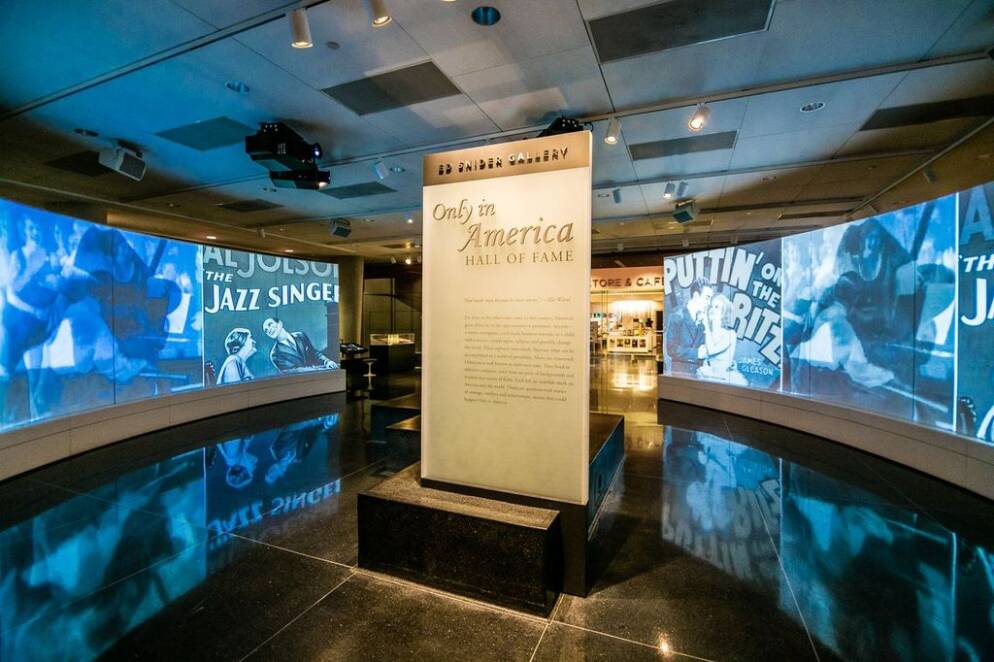 The Weitzman’s Only in America Gallery®/Hall of Fame (Photo credit: David Rosenblum)
The Weitzman’s Only in America Gallery®/Hall of Fame (Photo credit: David Rosenblum)
In 2024, the Weitzman National Museum of American Jewish History took big steps toward becoming a Smithsonian institution. The United States Congress passed a bill, signed in December by then-President Joe Biden, that created an eight-member panel of experts to make a recommendation on whether the Weitzman should join the federal government-run organization of museums and educational centers. The board was given a two-year deadline to announce its decision.
With the clock ticking, the board is still being formed, but the Weitzman is already making its case.
In 2026, the museum that seeks to become the nation’s main center of Jewish-American history will unveil three new exhibits on that subject. The first, a temporary exhibit that will open on April 23, is a tribute to the United States’ 250th anniversary. Called “The First Salute,” it will tell the story of St. Eustatius, the tiny Caribbean island that became the first foreign government to recognize the U.S. with an 11-gun salute to a visiting U.S. ship.
British Admiral George Rodney responded by blaming the island’s Jews. He rounded them up and stripped them of their property and possessions. But Rodney’s focus on the island was costly; it distracted him from the French ships that were crossing the Atlantic, coming to help U.S. forces fighting the British in the Revolutionary War.
The Weitzman’s second exhibit, which will premiere in July, is a permanent exhibit for children and families. It will use colorful displays to tell the biblical story of the world’s creation to kids. Visitors will walk through exhibits portraying God’s first six days of work before ending at the seventh, the day of rest.
The third and final display, set to open by the fall, will focus on contemporary antisemitism. It will feature three-minute videos in which American Jews will discuss their experiences with anti-Jewish hate. As Dan Tadmor, the Weitzman’s president and CEO, explained, “it’s not Tree of Life; it’s not the Capital Jewish Museum shooting; it’s not Colleyville.” Those were prominent, tragic incidents. These are day-to-day experiences, he said. This is the best way to tell the story in an era when antisemitic incidents keep rising year to year, Tadmor noted.
“This museum opened in 2010 in its current location, and it really doesn’t have a section that deals with contemporary antisemitism,” he said. “We thought then that it’s a relic of the past. We’ve been proven wrong.”
 A view of the layout of “The First Salute” (Rendering by G&A)
A view of the layout of “The First Salute” (Rendering by G&A)
Before COVID, bankruptcy and the donation from shoe designer Stuart Weitzman that kept it open, the National Museum of American Jewish History was known for celebrating Jewish life in America and great American Jews like the influential music executive Bill Graham.
Tadmor, who succeeded Misha Galperin as Weitzman CEO earlier this year, still sees the museum’s mission as highlighting Jewish contributions to America. In fact, that’s what “The First Salute” is all about. Although they were not in America, the Jews of St. Eustasius supported the Continental Army and helped provide it with gunpowder and other supplies.
“Jews participated heavily in the shipping,” said Josh Perelman, the exhibit’s curator.
The “First Salute” exhibit will include films, artifacts, storytelling and an immersive video experience, according to a Weitzman press release. Along with the other two new displays, it should cost in the range of $12 million, $10 million of which has been raised from the likes of the Elaine L. Lindy Donor Advised Fund, the Pennsylvania Redevelopment Assistance Capital Program and other sources.
Tadmor said it usually takes “several years” to hit a fundraising goal when large donations are involved. The Weitzman has come close to hitting this one in less than a year. Donors have been both Jewish and non-Jewish, local and national, foundations and individuals.
“It’s like the world has been waiting for the nation’s Jewish museum to reimagine itself,” Tadmor added. “Once we came forward with a plan that made sense, it really resonated. People were enthusiastic to get on board.”
